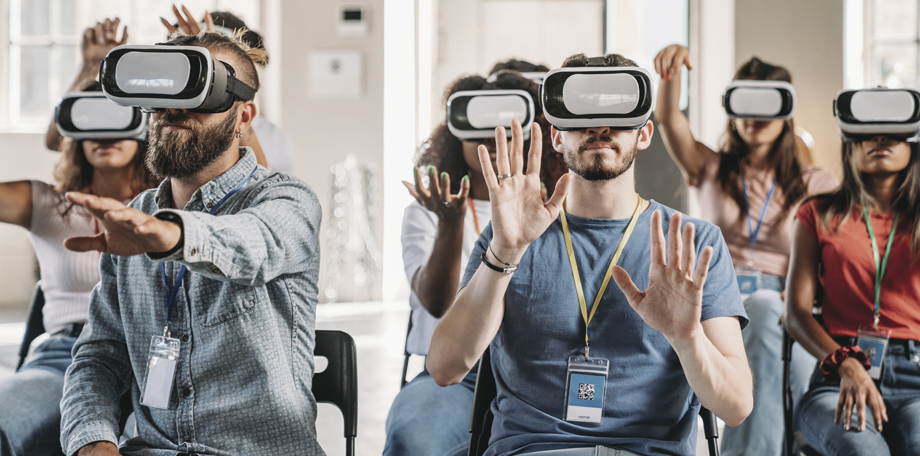Before the pandemic, we had all heard about virtual and augmented reality (remember Pokémon GO back in 2016?). However, the shift toward remote and hybrid work has fast-tracked their roles in the modern workplace. More companies are adopting strategies for using these technologies, from training to job recruitment.

These technologies reached $28 billion in 2021 and are expected to grow to more than $220 billion by 2028. Apple’s CEO Tim Cook has even said that AR will one day be as important in our everyday lives as “eating three meals a day.”
VR and AR 101
But first, what exactly is VR (virtual reality) and AR (augmented reality)? Both technologies merge a virtual world with the real one with enhanced, 3-D visuals. It can be easy to mix up the two, so let’s take a look at each.
AR is easily accessible to anyone with a smartphone. It morphs the physical world with a more visual one by projecting virtual pictures and characters. It’s simply adding on to the user’s real-life experience.
VR takes these components to a higher level by producing an entirely computer-generated simulation of an alternate world. You typically need to wear a headset device and have a handset or gloves to interact in the alternate space.
Careers in VR/AR
These new technologies open up a slew of new careers to support their growth in many different industries, such as:
- Software engineering and development
- Hardware development
- Research
- Coding
- Graphic design
I recently spoke with an acquaintance who works in this field about how it’s become a game changer in the workplace. She’s a freelancer but notes larger organizations such as Meta (formerly Facebook), Microsoft and Epic Games (which owns Fortnite, a popular multiplayer game that enables users to interact with each other online – ask your kids about it) are hiring full-time positions since they have invested so much into what’s called the “metaverse” (a term originally coined by author Neal Stephenson in 1992 to describe a future world of virtual reality.) One of the biggest areas of potential for corporations using these technologies is in training.

The Future of Corporate Training
VR training has been around for decades but typically only for high-stakes positions such as military pilots, surgeons and astronauts. Now that VR is becoming more commonplace partly due to lowered implementation costs, we’re seeing it at work in industries like retail, insurance, customer service and even in schools. It’s a new way to train employees and students safely, effectively and efficiently.
The Harvard Business Review reports that Walmart has trained over a million of its employees in VR. Trainees learned how to operate what’s called “The Pickup Tower” – a large kiosk for customers to pick up online orders. During the interactive training, they get immediate feedback when they make mistakes. Before VR, each person spent an entire day training inside stores. VR reduced the training from eight hours to just 15 minutes, with no decrease in effectiveness.
In coaching, we talk a lot about “soft skills” those non-technical skills that relate to how you work rather than the technical skills needed to perform your job. Soft skills are an important part of being a manager, from how you deal with an irate customer to how you present to your employees. One way VR is a game changer is in teaching public speaking. Instead of having to assemble a room full of people for practice sessions, it’s much easier to don a headset and learn to speak to a fictional audience. Experiments show that people take the training seriously, but they are less self-conscious. It’s a good stepping stone to becoming a great public speaker.
Verizon is just one company using VR training for call-center employees on dealing with customer issues. According to data collected by Verizon, the employees were more confident in dealing with real-life customer scenarios after the training because they were more aware of themselves when handling the customer. It’s like a mini lesson in self-awareness!
Sprouts Farmers Market, the supermarket chain, uses VR as a way to onboard new employees. They created VR experiences to teach the company’s core values. They tested 300 employees, half who did VR training and the other half who did the original PowerPoint training. The results showed 48% of the trainees who did VR learned all company concepts perfectly, compared to only 3% who used traditional methods.

AR in Business
Companies are using AR in ways to increase sales and create innovative marketing campaigns. You may already be using AR while shopping without even realizing it. Think of trying on a new funky pair of Warby Parker glasses virtually, or a new shade of lipstick at Sephora without having to touch that well-used tester or placing a new piece of IKEA furniture in your living room to see how it fits, all by simply by using a smartphone.
But there are factors dissuading retailers from jumping onto the AR bandwagon, mainly implementation costs, finding appropriate use cases and keeping up with rapidly changing technology. Mobile Marketer reports more than half of retails say they are still not ready to integrate AR into their shopping experiences. However, customers feel differently: 56% of shoppers surveyed by NielsenIG hives them more confidence about the quality of a product and 61% said they prefer to shop with retailers that offer AR experiences.
Work in the Metaverse
Meanwhile, the metaverse has become big business. This network of 3-D virtual worlds where people can interact, do business and make social connections through their avatars is where more and more people are spending all hours of the day. I thoroughly enjoyed this recap of time spent in Mark Zuckerberg’s Horizon Worlds (Meta’s universe in the metaverse) in the New York Times, and if you are unfamiliar with how this all works, this piece will shed some clarity.
But in addition to going to a comedy show and rearing virtual pets, the metaverse provides an opportunity for more interactive work experiences for remote and hybrid workers. Companies like NextMeet based in India provide an immersive platform to help keep employees engaged. Employee avatars can give live presentations, visit virtual offices and meeting rooms, even walk a 3-D hall to interactively learn about the company.
We know that remote work makes it hard to separate home and work life, so some companies are banking on virtual workplaces creating a more clear distinction. If you could walk into your virtual workplace in the morning, leave for your lunch break (perhaps for a quick walk through a dense rain forest?), stay connected to work during a meeting and then say goodbye to your colleagues at the end of the day, would you feel like you actually left for work without ever actually leaving home? Those investing in the metaverse certainly hope so.
Gather, an international virtual reality platform, allows employees and organizations to “build their own office.” Would you choose to work from a space station or a Zen garden? The possibilities could one day be endless!

Will VR/AR Replace Humans?
VR and AR are excellent examples of how humans and machines can work together to be more efficient. We can get information faster by accessing a virtual assistant rather than a manual. But will these technologies eventually replace humans?
As a coach, I can see relevant applications for this technology in my field. For example, we offer interview coaching here at JMA. That involves a person searching for a job practicing through mock interviews either in-person or via Zoom. The goal is to put the candidate in the same environment as the day of your interview.
Could this be achieved with an app with artificial intelligence generating questions? It could certainly be a starting point. But there’s nothing like that human interaction to prepare you for a nerve-wracking job interview. We help candidates understand why they may have fumbled a question and give them strategies to get through the stress successfully. I’m not convinced a bot would be able to throw the same curve ball as some of our coaches!
Organization Metamorphosis
We are in an era of workplace transformation. Think back to just a few years ago when remote and hybrid work weren’t common at all. In that short time, we have rewritten the playbook on how, where and why people work. The career opportunities coming with the infinite possibilities of the metaverse will continue to develop. This is an opportunity for companies to reinvent their workplaces of the future – to capture the collective, interactive and fun atmosphere of in-person of work while maintaining the flexibility, productivity and convenience of remote and hybrid work.
